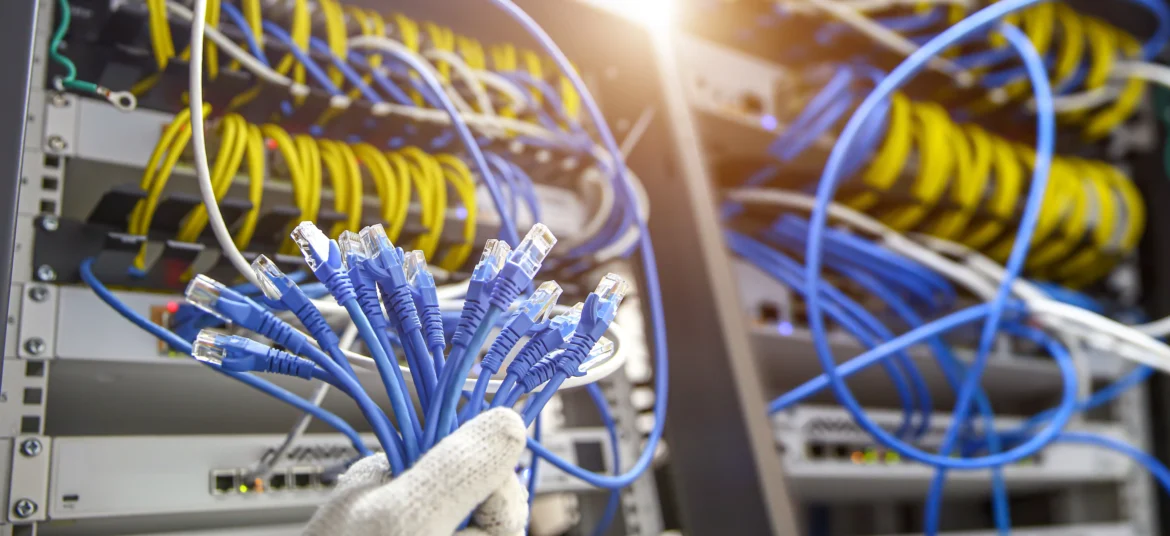Fiber optics, whose impact on communications has been monumental, is an advanced technology that has transformed the way we share information. To fully understand how it works, it is essential to explore its composition and materials, as well as to compare it with other transmission media.
Composition and materials
Optical fiber is composed primarily of glass or specialized plastic, designed to transmit light signals over significant distances with minimal loss of intensity. This transparent core is surrounded by a reflective coating layer, which allows light to propagate through total internal reflections.
In more technical terms, the core of the optical fiber has a lower refractive index than the cladding. This design ensures that light, upon entering the core, bounces repeatedly off the internal walls at specific angles, preventing fundamental signal loss.
The quality of the materials used is crucial. Ultra-thin silica glass is commonly preferred for the core, and various coatings, such as plastic, are applied to ensure ideal optical properties. This meticulous approach to compounding ensures transmission efficiency and reliability.
Comparison with other means of transmission
Compared to traditional transmission media, fiber optics stands out for several reasons. First, it significantly outperforms copper cables in terms of speed and bandwidth capacity. Light can transmit data at speeds close to the speed of light, enabling much faster data transmission.
In addition, unlike copper cables, optical fiber is immune to electromagnetic interference and radio frequencies. This interference resistance ensures more stable and reliable data transmission, especially in environments with multiple sources of interference.
Another crucial aspect is signal loss during transmission. While copper cables can experience significant signal losses over longer distances, optical fiber can transmit data over much greater distances with minimal losses.
Fiber optics also stands out for its noise resistance and inherent safety. Since the information is transmitted through pulses of light, it is more difficult to intercept than electrical signals on copper wires, providing an additional level of security.
Fiber optics is emerging as the backbone of modern communications, providing not only efficiency, but also reliability and security. Its ability to transmit data at breakneck speeds and resist interference makes it the preferred choice for building the connectivity infrastructure of the future. Understanding its composition and advantages over other media is essential to fully appreciate its impact in today’s digital age. Fiber optics not only connects; it drives innovation and sets the standard for the next generation of communications.

Fiber optic fiber types: differences and uses, characteristics and capacities
Optical fiber, as the mainstay of modern telecommunications, has several types, each with specific characteristics that make them suitable for different applications. Understanding the differences between these types is essential to take full advantage of this revolutionary technology.
Fiber optics: a detailed look
Fiber optics is a data transmission conduit that uses light to carry information from one point to another. Its basic composition involves a transparent core, usually glass or plastic, surrounded by a layer of reflective coating. These elements work together to ensure the efficient transmission of light signals, but the types of optical fiber vary according to their intrinsic characteristics.
Types of optical fiber:
Single-mode fiber (SMF)
Single-mode optical fiber is known to have a single mode of propagation, which means that it allows only one wavelength of light to travel through the core. This eliminates modal dispersion, facilitating faster and more efficient transmission. This type of fiber is commonly used in long distance applications, such as intercontinental connections and network backbone links.
Multimode Fiber (MMF)
Unlike single-mode, the “Multimode” type of optical fiber allows the propagation of multiple light modes through its core. Although this can result in modal dispersion, it is ideal for shorter distances and applications where speed is not critical. Connections in buildings and data centers typically use multimode fiber.
Differences and uses:
The choice between single-mode and multimode fiber depends on the distance and speed required. Single-mode excels in longer distances and high-speed applications, while multimode is more suitable for shorter distances and moderate speeds.
Fiber optics characteristics and capabilities: a detailed approach
Fiber optics, the backbone of modern communications, is distinguished by its unique ability to transmit data using light beams. Exploring its features and capabilities reveals a technology that redefines connectivity. In this detailed analysis, we highlight key points that underscore the essential role of fiber optics in our communication networks.
Exceptional bandwidth
Single-mode fiber emerges as the undisputed leader in terms of bandwidth. Its ability to provide a wider spectrum far exceeds multimode, making it the preferred choice for applications requiring high data throughput. Fiber optics, especially in its single-mode variant, thus becomes the driving force behind the fast and efficient transmission of large volumes of information.
Fiber optics, with its exceptional bandwidth, is positioned as the ideal choice to meet the ever-increasing demands of data transmission in today’s digital world.
Reduced attenuation
A crucial aspect of optical fiber is its ability to minimize attenuation, the loss of signal during transmission. In this respect, single-mode fiber stands out by offering significantly lower attenuation. This feature allows data transmission over considerable distances without sacrificing signal quality, ensuring reliable and high quality connections over large infrastructures.
Single-mode fiber, by reducing attenuation, ensures stable, high-quality connections even in environments requiring significant transmission distances.
Diversity in Connectivity
Fiber optics present variations in connectivity depending on the type of fiber. Single-mode, due to its high specificity, usually requires more expensive and precise light sources. In contrast, multimode uses more affordable and common light sources, making it a practical choice for short distance connections and less demanding applications in terms of speed.
The choice between single-mode and multimode fiber is tailored to specific needs, from high-demand connections to more common and affordable applications.
By integrating these features and capabilities, fiber optics is revealed as a fundamental element in the evolution of communication networks. Its ability to deliver exceptional bandwidth, reduce attenuation and adapt to diverse connectivity needs positions it as the technology of choice in data transmission. Fiber optics, with its bright and efficient light, illuminates the way to a future of fast, stable communications adapted to the growing demands of our digital era.
Fiber optics, with its unique ability to transmit data via light beams, redefines modern connectivity, providing exceptional bandwidth and adapting to diverse connectivity needs.

Advantages of fiber optics:
High bandwidth: Fiber optics stands out for offering a significantly higher bandwidth than other transmission media. This feature enables the transfer of large amounts of data at impressive speeds, meeting the growing demand for fast connectivity.
Lower attenuation: One of the greatest strengths of optical fiber is its ability to maintain low attenuation rates. Signal loss is minimal, making it possible to transmit data over considerable distances without compromising signal quality.
Immunity to electromagnetic interference: Unlike copper cables, optical fiber is immune to electromagnetic interference. This resistor ensures more reliable communication by avoiding disturbances caused by magnetic and electric fields.
Increased security: Information security is a critical aspect in the digital age. Optical fiber offers a higher level of security, as it is difficult to intercept without leaving a trace. This feature makes it a preferred choice for the secure transmission of confidential data.
Implementation of environmental and sustainability aspects in FTTH networks.
The implementation of fiber optic networks (FTTH) has not only revolutionized Internet connectivity and speed, but has also opened an essential dialogue on the environmental and sustainability aspects of these technological infrastructures. Fiber optics has driven a significant shift towards more sustainable and environmentally friendly practices.
One of the most outstanding aspects in terms of sustainability in FTTH networks is energy efficiency. Unlike older technologies, optical fiber requires less energy to transmit data over valuable distances. This translates into a fundamental reduction of the carbon footprint associated with the network infrastructure, thus contributing to a more sustainable environment. Energy efficiency is a key element to consider, especially in an ever-expanding digital world.
From energy efficiency to using more sustainable materials and reducing e-waste, this technology offers a solid alternative to meet our growing connectivity needs without compromising the future of the planet. The conscious implementation of FTTH networks based on fiber optics not only drives technological progress, but also promotes a path towards a more sustainable and balanced digital future.



